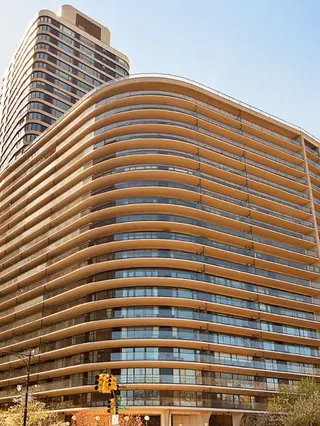 Carter Horsley
Carter HorsleyDec 23, 2011
Carter's Review
This 35-story tower at 200 Central Park South on the southwest corner at Seventh Avenue is one of the most distinctive in the city with its broadly curved corner and continuous bands of balconies in its 21-story base.
Built by Bernard Spitzer and Melvin D. Lipman, and designed by Wechsler & Schimenti, this beige-brick tower commands spectacular views of Central Park and the curved façade permits more apartments to have park views.
The building was erected in 1963 and converted to a cooperative in 1984. It has 309 apartments and is directly across Seventh Avenue from the very handsome New York Athletic Club. This white-glove building's amenities and services include 24-hour doorman/concierge, manned elevators, fitness center, bike room, on-site garage, circular driveway, valet service, central laundry, and roof observatory with views of Central Park and the city skyline.
Bottom Line
Apart from its stupendous vistas of Central Park and curved, glass-railed balconies in its 21-story base, the building's location is extremely convenient both to Midtown and the Lincoln Center district.
Description
The building’s setback tower occupies the top 14 floors is not curved, but has angled corner windows to maximize views. The tower's façade has a horizontal fenestration pattern that continues the banding motif of the base, albeit without balconies.
The building's entrance is landscaped and spacious at the busy corner, which is an exit for the Central Park Drive south road.
Amenities
The building has a health club, a sun deck, a bicycle room, a 250-car garage and a 24-hour concierge. It also has a live-in superintendent.
Maid and valet service is available.
Apartments
Apartment 14F is a studio unit with a 10-foot-long entry foyer that opens onto a 21-foot-long living room with an 8-foot-long dining bay next to an 8-foot-long kitchen.
Apartment 11G is a one-bedroom unit with an angled entry foyer that leads past a 16-foot-long enclosed, windowed kitchen to a 25-foot-long living room with a terrace and an 18-foot-long, open and windowed dining room.
Apartment 14H is a one-bedroom unit with an 11-foot-long entry foyer that opens onto a 19-foot-long living room with a 9-foot-long open kitchen with an island and a 10-foot-long dining area and a balcony.
Apartment 20G is a two-bedroom unit with a long entry foyer that leads past a 16-foot-long, slightly angled, windowed kitchen to an 11-foot-long gallery that opens onto a 25-foot-long living room.
Apartment 33C is a one-bedroom unit that has a 16-foot-long, slightly curved entry foyer that leads past a 12-foot-long, enclosed and windowed kitchen to a 16-foot-long gallery that opens onto a curved, 19-foot-wide dining area and a six-sided, 24-foot-long living room with two corner bay windows.
Apartment 15B is a two-bedroom unit that has a 10-foot-long entry foyer that leads past a 13-foot-long kitchen to a huge open space fronting on a the very large curved balcony with a 14-foot-long dining room, a 24-foot-long living room, and a 17-foot-long library.
History
The building's design was described by Robert A. M. Stern, Thomas Mellins and David Fishman in their book, "New York 1960, Architecture And Urbanism Between The Second World War And The Bicentennial," (The Monacelli Press, 1995), as "a kind of aggressive, self-referential Modernism that had hitherto been largely absent from Manhattan."
In a December 9, 1977 article in The New York Times, Paul Goldberger wrote that “the extravagant curving façade” was one of several buildings on the street “worth special note,” adding that it “had been laughed at as a New York outpost of Miami Beach for years,” but “it looks better and better upon close examination, though.”
“The swooping curve is not a bad way at all for a large avenue to meet Central Park, and the narrow tower on top is an amusing imitation of Frank Lloyd Wright’s Johnson Wax Company tower. The details are a bit crude, and the fountain in front is downright awful, but these aspects aside, 200 Central Park South is deserving of real praise,” according to Mr. Goldberger.
Fountains in front, however, cannot possibly be “downright awful.”
A March 25, 1962 article in The New York Times reported that “a gasoline station, a twelve-story professional building, an art gallery, a bar and grill and the Century Theater, which in its last years was used for television shows, were demolished to make room for the new building.

- Co-op built in 1963
- 3 apartments currently for sale ($1.395M to $18.9M)
- Located in Midtown West
- 309 total apartments 309 total apartments
- 10 recent sales ($830K to $6M)
- Doorman
- Pets Allowed
 6sqft delivers the latest on real estate, architecture, and design, straight from New York City.
6sqft delivers the latest on real estate, architecture, and design, straight from New York City.
